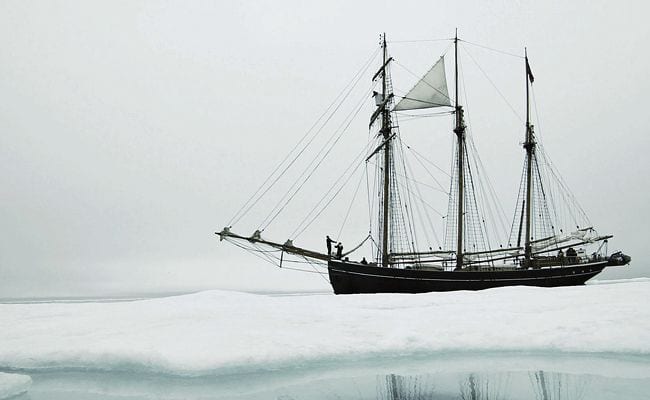
Photo above by Simon Rubardo
“The notion of the end of the world is unique to man,” says Tal R, gesturing vibrantly with a pencil as he speaks. “Imagine if the mountains shared the thought. They just change colors. Ten million years slip away and then they have a new layer.” The artist pauses, gazing at the mountainous cliffs of northeastern Greenland. “There’s a lot of hope in a brutal landscape like this.”
That’s not to say it would be easy to find another “landscape like this,” where Tal R has traveled for the documentary, Expedition to the End of the World (Ekspeditionen til verdens ende). He and a group of other Danish artists and scientists spend their time hiking and hunting, sketching and studying, appropriately awed by their surroundings and trying to make some rational or poetic sense of it.
Such sense-making involves observing and conversing and recording, with instruments that don’t start or break down, that measure and gyrate. These measures are both precise (marine biologist Katrine Worsaae observes tiny organisms under her microscope) and aesthetic (Tal R sketches, photographer Per Bak Jensen takes shots), each an effort to put the beauty into some other form, to compare it to something else, to describe it in a way that someone else might understand. The process is fascinating, especially as it is back-dropped, repeatedly, by scenes of frankly unspeakable splendor, the world at its most vivid, transcendent, and immediate, at its most untouched by humans.
As Daniel Dencik’s film begins, the crew arrives on a ship, identified on screen only by their occupations, their faces instantly more complex and compelling than any such single phrase might indicate: as the geologist, the captain or the zoologist squint in the sun glinting off ice floes and bergs, white masses that are melting even as you look on them. Accompanied by Mozart’s Requiem or Metallica‘s “Blackened,” these lung duration panning shots suggest time passing and also, a kind of endlessness. While the world is changing now, if climate change has visible, frightening consequences — as Expedition to the End of the World, currently screening at Film Forum, makes clear enough—it is, nonetheless, not about to end, even if your part in it might be ending.
“Our job,” says Per Bak Jensen, meaning both artists and scientists, all readers of the world and each other, is to “find out what is really going on, what is happening to us.” Yes, nods archeologist Jens Fog Jensen: “What’s cooking here on planet earth.” Behind them, as they hunch their shoulders in their winter gear, you see water and sky and ice and mountains. What is happening to us is happening to these elements too, as well as the polar bears and fish and seals who occasionally show up in frame, impressing the humans even as they hardly notice the humans. I was talking to the geochemist last night. The photographer says, “He’s so interested in the age and contents of the soil and how it ended up here, but he actually admitted that he was somehow also searching for something within himself when he went looking for something in the soil.”
But of course. Standing over a fossilized algae mat he’s collecting, geologist Minik Rosing points out, “All organisms on earth are connected, there’s no big difference between the way we work and the way microorganisms work. We’re just put together in a way that looks smarter.” His assistants lift the wooden sled they’ve built to carry the fossil, taking it to the ship, and Rosing continues, while he too heads back to the ship, “So, in many ways, we’re some kind of algae mat. Some more so than others.”
The similarities and connections between forms of life, their effects on one another, extends as well to nonliving bodies, to rocks and mountains, all mats too, all ever shapeshifting, whether changing colors or adding layers. This point is made by close shots of bugs scrabbling on weather-beaten mounds as much as by long, long shots of tiny men on vast shores. A few scenes later, Rosing goes on, “Actually, it’s life that controls earth’s geological machinery. When I figured that out, I was overwhelmed and thought that something must be wrong, but the more you look at it, the more it must be correct that living organisms are the main machine in how the earth works.” As soon as he says it, you might think it obvious, but think again, and you can appreciate how overwhelmed he might have been, pondering the intricacy of interrelations between earth and humans, pondering how to put that intricacy into language and also, to use.
Helpfully, as the geologist and other scientists study the earth, as they work to determine the past it preserves and also erodes, they offer comparisons language to situate you. “The uncertainty is good,” says Tal R in conversation with geographer Bo Eberling. “If you’re into stuff like this, then the whole world is a crime scene.” Extinction is part of a cycle over millions of years, so slow as to seem illegible. True, Katrine Worsaae observes, “It never happened before that a single species created such mass extinction,” but extinction isn’t unique to us, even if our capacity to think it might be. And so you’re back to this problem of thought, awareness that might make “the end of the world” terrifying — if denial weren’t part of the process too. For a few minutes anyway, the film helps you to look at the earth, so majestic, so superb, and to want more than ever to be aware.


![Call for Papers: All Things Reconsidered [MUSIC] May-August 2024](https://www.popmatters.com/wp-content/uploads/2024/04/all-things-reconsidered-call-music-may-2024-720x380.jpg)



